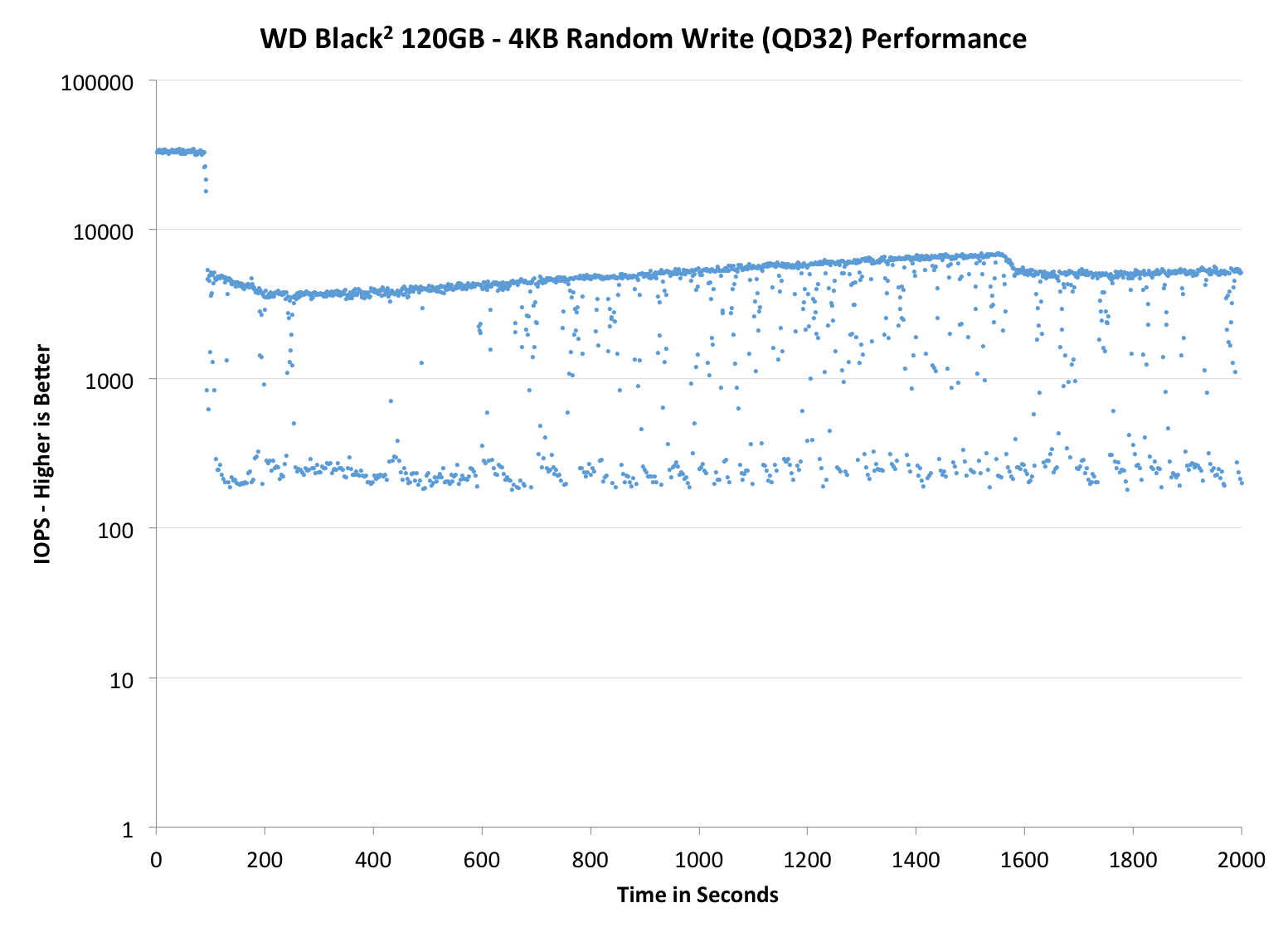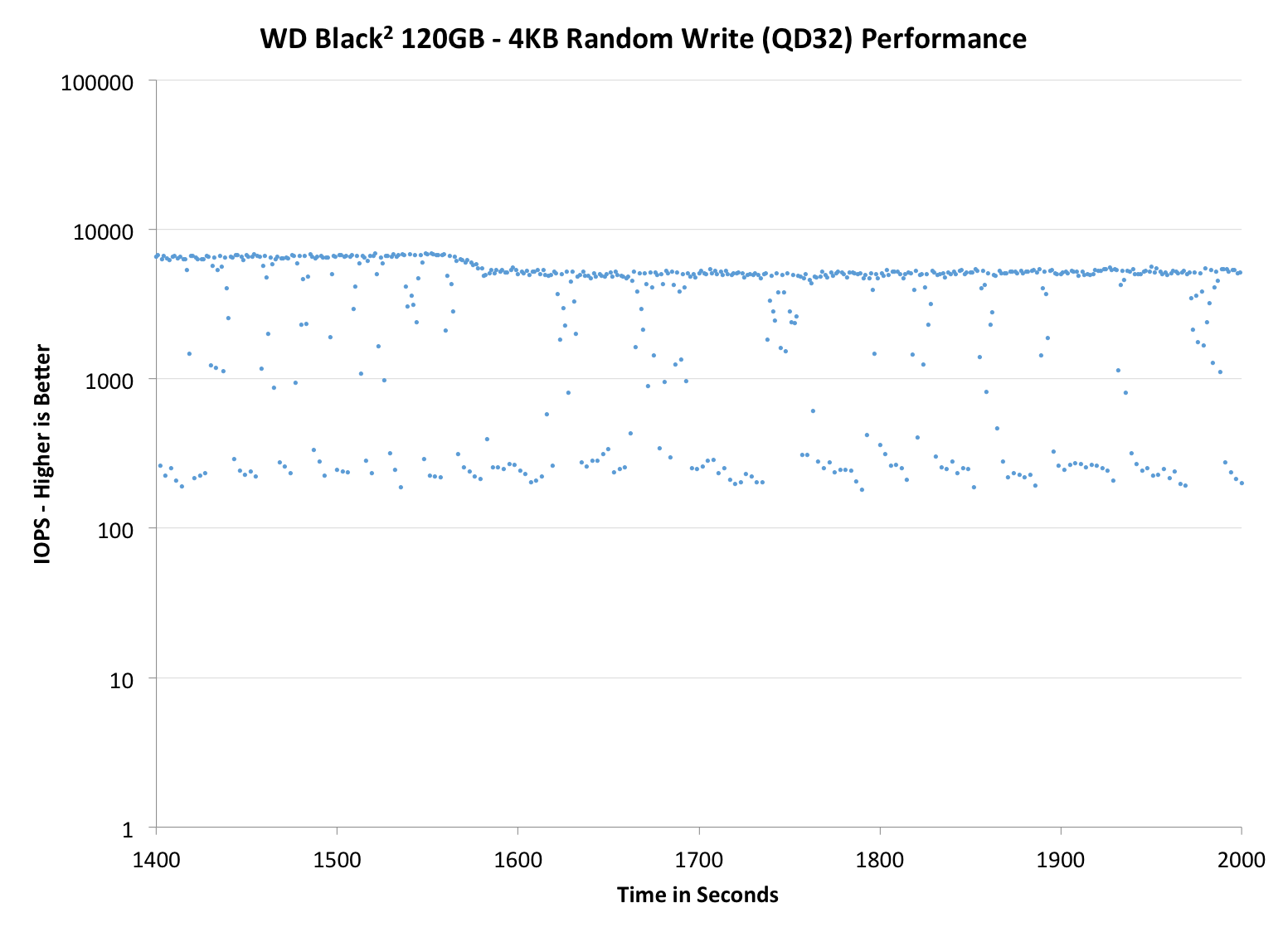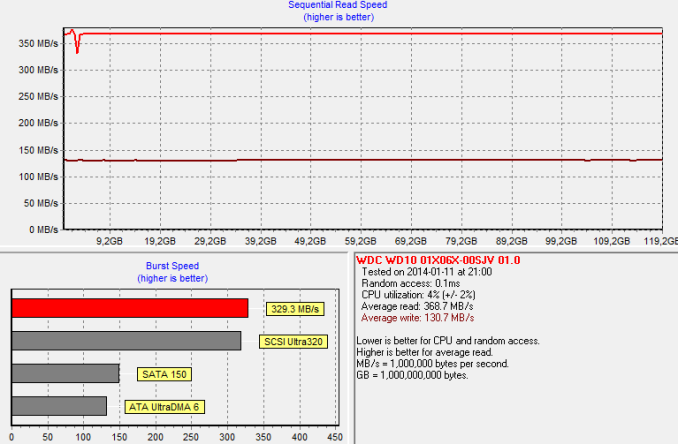The WD Black2 Review: World's First 2.5" Dual-Drive
by Kristian Vättö on January 30, 2014 7:00 AM ESTPerformance Consistency
Performance consistency tells us a lot about the architecture of these SSDs and how they handle internal defragmentation. The reason we don’t have consistent IO latency with SSD is because inevitably all controllers have to do some amount of defragmentation or garbage collection in order to continue operating at high speeds. When and how an SSD decides to run its defrag or cleanup routines directly impacts the user experience as inconsistent performance results in application slowdowns.
To test IO consistency, we fill a secure erased SSD with sequential data to ensure that all user accessible LBAs have data associated with them. Next we kick off a 4KB random write workload across all LBAs at a queue depth of 32 using incompressible data. The test is run for just over half an hour and we record instantaneous IOPS every second.
We are also testing drives with added over-provisioning by limiting the LBA range. This gives us a look into the drive’s behavior with varying levels of empty space, which is frankly a more realistic approach for client workloads.
Each of the three graphs has its own purpose. The first one is of the whole duration of the test in log scale. The second and third one zoom into the beginning of steady-state operation (t=1400s) but on different scales: the second one uses log scale for easy comparison whereas the third one uses linear scale for better visualization of differences between drives. Click the buttons below each graph to switch the source data.
For more detailed description of the test and why performance consistency matters, read our original Intel SSD DC S3700 article.
 |
|||||||||
| WD Black2 120GB | Samsung SSD 840 EVO mSATA 1TB | Mushkin Atlas 240GB | Intel SSD 525 | Plextor M5M | |||||
| Default | |||||||||
| 25% OP | - | ||||||||
The area where low cost designs usually fall behind is performance consistency and the JMF667H in the Black2 is no exception. I was actually expecting far worse results, although the JMF667H is certainly one of the worst SATA 6Gbps controllers we've tested lately. The biggest issue is the inability to sustain performance because while the thickest line is at ~5,000 IOPS, the performance is constantly dropping below 1,000 IOPS and even to zero on occasion. Increasing the over-provisioning helps a bit, although no amount of over-provisioning can fix a design issue this deep.
 |
|||||||||
| WD Black2 120GB | Samsung SSD 840 EVO mSATA 1TB | Mushkin Atlas 240GB | Intel SSD 525 | Plextor M5M | |||||
| Default | |||||||||
| 25% OP | - | ||||||||
 |
|||||||||
| WD Black2 120GB | Samsung SSD 840 EVO mSATA 1TB | Mushkin Atlas 480GB | Intel SSD 525 | Plextor M5M | |||||
| Default | |||||||||
| 25% OP | - | ||||||||
TRIM Validation
To test TRIM, I first filled all user-accessible LBAs with sequential data and continued with torturing the drive with 4KB random writes (100% LBA, QD=32) for 30 minutes. After the torture I TRIM'ed the drive (quick format in Windows 7/8) and ran HD Tach to make sure TRIM is functional.
Based on our sequential Iometer write test, the write performance should be around 150MB/s after secure erase. It seems that TRIM doesn't work perfectly but performance would likely further recover after some idle time.











100 Comments
View All Comments
chizow - Friday, January 31, 2014 - link
Hmm yeah you're right, I didn't know this was priced so high at $290 and 1TB SSDs are in that $500-600 range now from what I've seen.This would probably need to drop down to ~$180 to be worthwhile, based on pricing of a 120SSD ($80ish) and 1TB 2.5" HDD ($80) with a small premium for combined slot.
Braumin - Thursday, January 30, 2014 - link
This is a bit silly. If they had gone to the trouble of merging the two into a single logical unit, it would make more sense.As you rightly pointed out - it makes little sense to anyone. If you need more space, you can do that in so many other ways...
This needed to be like the Fusion drive or it's DOA.
Mayuyu - Thursday, January 30, 2014 - link
Dead on Arrival. Device makers don't believe that consumers can handle a file manager. WD thinks people want to separate their files between a hard drive and a SSD?mikato - Friday, January 31, 2014 - link
I'm not giving it to my parents, that's for sure. They only get single drive systems. It may be an SSD if they keep dropping in price.speculatrix - Thursday, January 30, 2014 - link
Am I the only person who on seeing the picture of someone holding the nSATA card by its connector thinks "well, that's part ruined... likely to die early from ESD, or corrosion on the edge connector"?Gigaplex - Thursday, January 30, 2014 - link
The devices held like that for marketing purposes are often defective parts already.Gasaraki88 - Thursday, January 30, 2014 - link
I'm not seeing the point of this drive. Why don't I get a 128SSD and a 1TB drive separately?Gasaraki88 - Thursday, January 30, 2014 - link
They should have made this a hybrid drive. That would have been awesome, 128GB SSD cache with a 1TB spinning disk.kmmatney - Monday, February 3, 2014 - link
The Seagate Momentus XTs are already pretty nice with an 8 GB cache (I have 2 of the older models with 4GB cache, and even those are "pretty good"). So a hybrid with this much cache could be awesome. I don't think the hybrid drives cache writes, so that would limit performance. I'm on the fence with this - I think it needs to be priced around $200 to be more interesting.mr_tawan - Thursday, January 30, 2014 - link
Some people on a laptop does only have 1 bay for 2.5" drive available, with no mSATA socket whatsoever. Given that larger SSD is still quite expensive, you might have to choose between having a speedy system with no room for storage, and a plenty of space but slow as snail.These people might go with SSD and a USB3 HDD, of course, but carrying another external drive makes the system bit less mobile.
If the laptop has optical drive, then you might swap it with a 2.5" drive caddy. But it does not, well this might be a good option.
Too bad the drive does not really perform, and it's pretty pricey. I'd have gone with a drive caddy and a external bluray drive :-(.